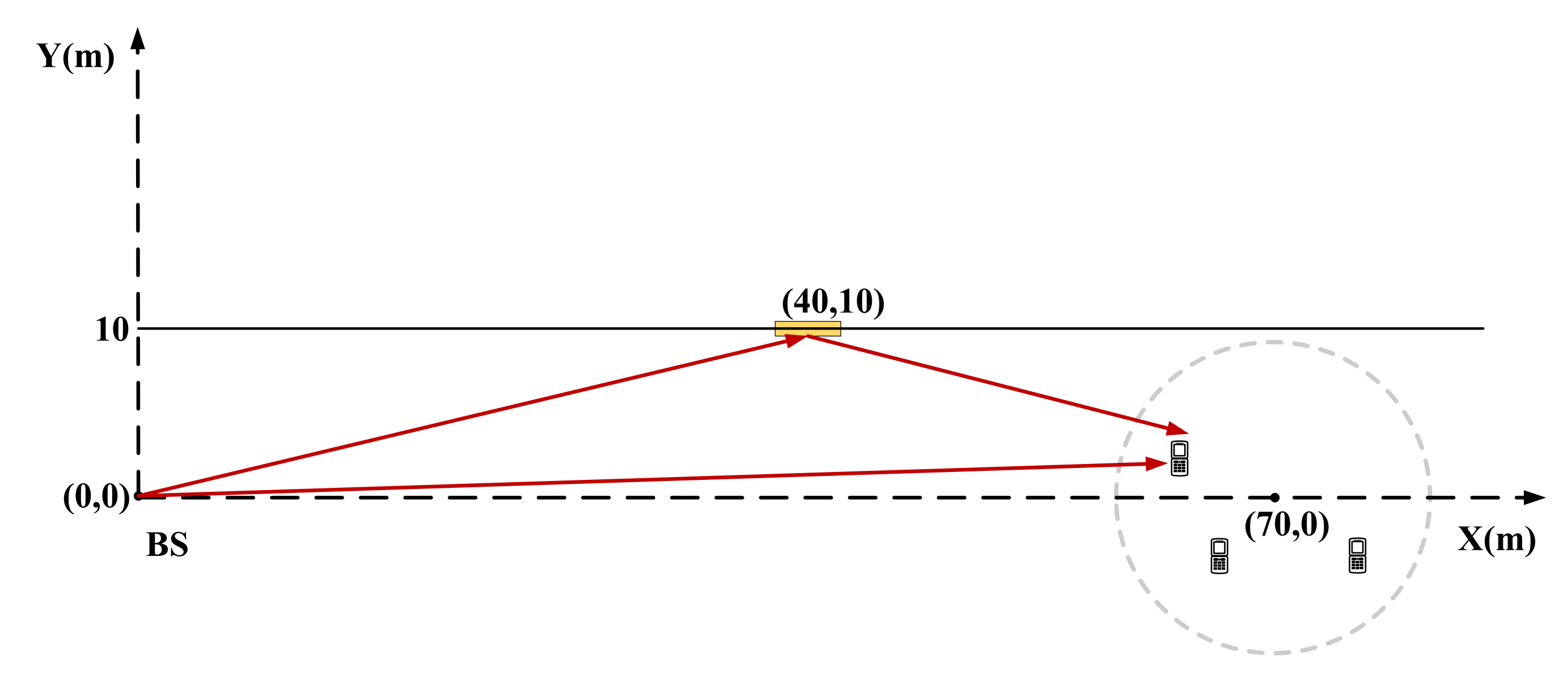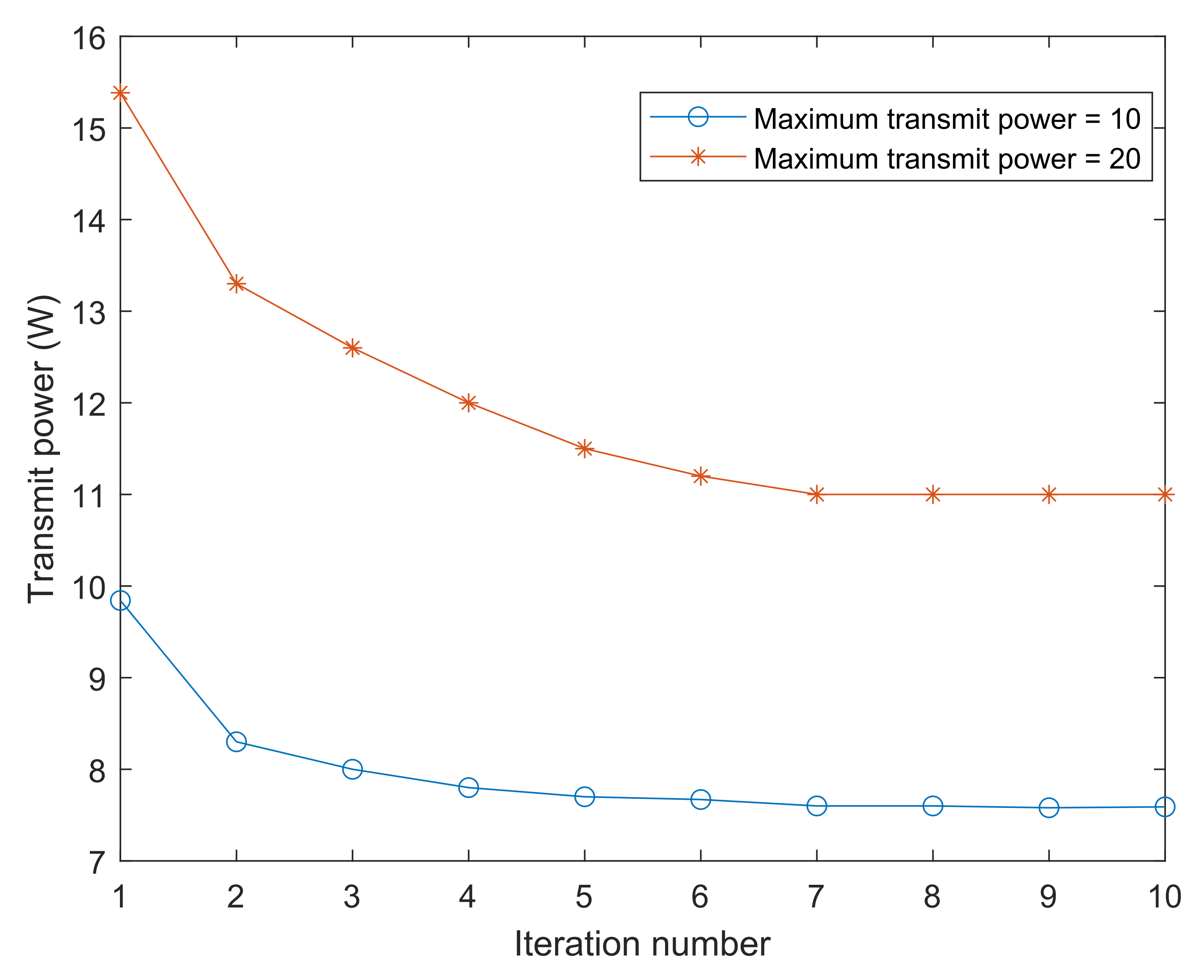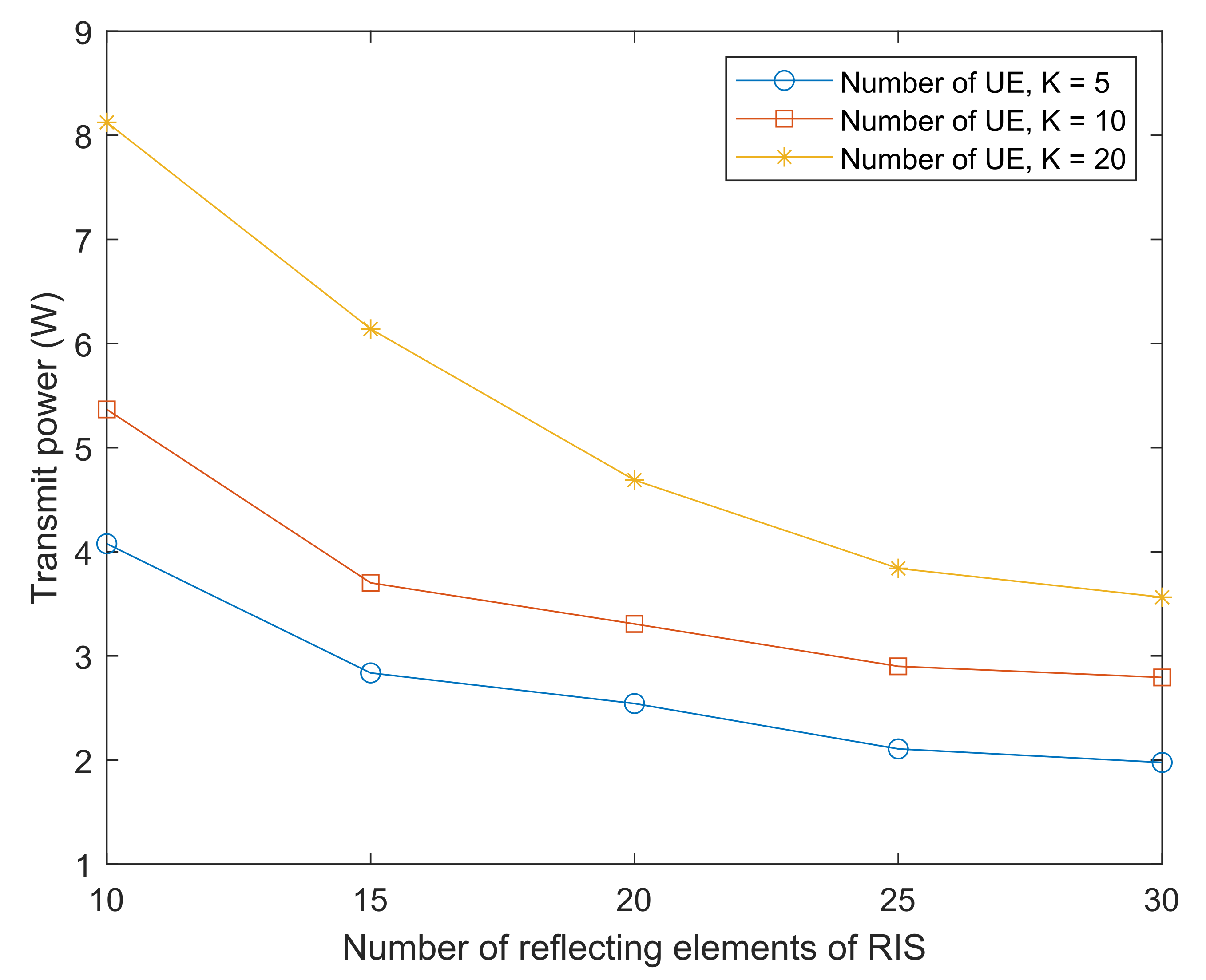High-Efficiency Power Optimization Based on Reconfigurable Intelligent Surface for Nonlinear SWIPT System
Abstract
:1. Introduction
2. System Model
2.1. Transmission Scheme
2.2. Non-Linear EH Model
3. Problem Formulation and Solution
3.1. Problem Formulation
3.2. Problem Transformation and Solution Procedure
3.2.1. Optimizing , , and with a Given
3.2.2. Optimizing with Fixed , , and
| Algorithm 1 Penalty-based algorithm for optimizing reflecting beamforming of RIS. |
|
| Algorithm 2 Alternating algorithm for minimizing transmit power consumption of BS. |
|
4. Simulation Results
5. Conclusions
Author Contributions
Funding
Institutional Review Board Statement
Informed Consent Statement
Data Availability Statement
Conflicts of Interest
References
- Li, X.; Zhang, C.; He, C.; Chen, G.; Chambers, J.A. Sum-Rate Maximization in IRS-Assisted Wireless Power Communication Networks. IEEE Internet Things J. 2021, 8, 14959–14970. [Google Scholar] [CrossRef]
- Pan, C.; Ren, H.; Wang, K.; Elkashlan, M.; Nallanathan, A.; Wang, J.; Hanzo, L. Intelligent reflecting surface aided MIMO broadcasting for simultaneous wireless information and power transfer. IEEE J. Sel. Areas Commun. 2020, 38, 1719–1734. [Google Scholar] [CrossRef]
- Bai, T.; Pan, C.; Deng, Y.; Elkashlan, M.; Nallanathan, A.; Hanzo, L. Latency minimization for intelligent reflecting surface aided mobile edge computing. IEEE J. Sel. Areas Commun. 2020, 38, 2666–2682. [Google Scholar] [CrossRef]
- Wu, Q.; Zhang, R. Joint Active and Passive Beamforming Optimization for Intelligent Reflecting Surface Assisted SWIPT under QoS Constraints. IEEE J. Sel. Areas Commun. 2020, 38, 1735–1748. [Google Scholar] [CrossRef]
- Deng, Z.; Pan, Y. Optimal Beamforming for IRS-Assisted SWIPT System with an Energy-Harvesting Eavesdropper. Electronics 2021, 10, 2536. [Google Scholar] [CrossRef]
- Yang, L.; Zeng, Y.; Zhang, R. Wireless Power Transfer with Hybrid Beamforming: How Many RF Chains Do We Need? IEEE Trans. Wirel. Commun. 2019, 17, 6972–6984. [Google Scholar] [CrossRef]
- Mahdi Elsiddig Haroun, F.; Mohamad Deros, S.N.; Ahmed Alkahtani, A.; Md Din, N. Towards Self-Powered WSN: The Design of Ultra-Low-Power Wireless Sensor Transmission Unit Based on Indoor Solar Energy Harvester. Electronics 2022, 11, 2077. [Google Scholar] [CrossRef]
- Albert, S. Wearable Circular Polarized Antennas for Health Care, 5G, Energy Harvesting, and IoT Systems. Electronics 2022, 11, 427. [Google Scholar]
- Chen, S.; Liu, D.; Zhao, Y. Target Localization and Power Allocation Using Wireless Energy Harvesting Sensors. Electronics 2021, 10, 2592. [Google Scholar] [CrossRef]
- Sarkar, N.I.; Singh, D.P.; Ahmed, M. A Survey on Energy Harvesting Wireless Networks: Channel Capacity, Scheduling, and Transmission Power Optimization. Electronics 2021, 10, 2342. [Google Scholar] [CrossRef]
- Ropokis, G.A.; Bithas, P.S. Wireless Powered Relay Networks: Rate Optimal and Power Consumption-Aware WPT/SWIPT. IEEE Trans.Veh. Technol. 2022, 71, 8574–8590. [Google Scholar] [CrossRef]
- Oleiwi, H.W.; Al-Raweshidy, H. Cooperative SWIPT THz-NOMA/6G Performance Analysis. Electronics 2022, 11, 873. [Google Scholar] [CrossRef]
- Wang, Z.S.; Lin, L.H.; Wen, J.H.; Lin, Y.J.; Weng, C.E. Performance Analysis of AF Cooperative Relaying Networks with SWIPT. Electronics 2022, 11, 589. [Google Scholar] [CrossRef]
- Selim, K.K.; Wu, S.; Saleeb, D.A.; Ghoneim, S.S. A Quad-Band RF Circuit for Enhancement of Energy Harvesting. Electronics 2021, 10, 1160. [Google Scholar] [CrossRef]
- Mansour, M.M.; Torigoe, S.; Yamamoto, S.; Kanaya, H. Compact and Simple High-Efficient Dual-Band RF-DC Rectifier for Wireless Electromagnetic Energy Harvesting. Electronics 2021, 10, 1764. [Google Scholar] [CrossRef]
- Sarker, M.R.; Saad, M.H.; Olazagoitia, J.L.; Vinolas, J. Review of Power Converter Impact of Electromagnetic Energy Harvesting Circuits and Devices for Autonomous Sensor Applications. Electronics 2021, 10, 1108. [Google Scholar] [CrossRef]
- Boshkovska, E.; Ng, D.W.K.; Zlatanov, N.; Schober, R. Practical Non-Linear Energy Harvesting Model and Resource Allocation for SWIPT Systems. IEEE Commun. Lett. 2015, 19, 2082–2085. [Google Scholar] [CrossRef]
- Mukherjee, P.; Lajnef, S.; Krikidis, I. MIMO SWIPT Systems with Power Amplifier Nonlinearities and Memory Effects. IEEE Wirel. Commun. Lett. 2020, 9, 2187–2191. [Google Scholar] [CrossRef]
- Ma, R.; Wu, H.; Ou, J.; Yang, S.; Gao, Y. Power Splitting-Based SWIPT Systems with Full-Duplex Jamming. IEEE Trans. Veh. Technol. 2020, 69, 9822–9836. [Google Scholar] [CrossRef]
- Ketcham, R.P.; Verdyck, J.; Moonen, M. Joint Beamforming and Power Allocation for Multiuser MISO Broadcast Channel SWIPT Employing OFDM. IEEE Access 2021, 9, 165154–165172. [Google Scholar] [CrossRef]
- Choi, K.W.; Hwang, S.I.; Aziz, A.A. Simultaneous Wireless Information and Power Transfer (SWIPT) for Internet of Things: Novel Receiver Design and Experimental Validation. IEEE Internet Things J. 2020, 7, 2996–3012. [Google Scholar] [CrossRef]
- Boshkovska, E.; Ng, D.W.K.; Zlatanov, N.; Koelpin, A.; Schober, R. Robust Resource Allocation for MIMO Wireless Powered Communication Networks Based on a Non-Linear EH Model. IEEE Trans Commun. 2017, 65, 1984–1999. [Google Scholar] [CrossRef]
- Wu, Q.; Tao, M.; Ng, D.W.K.; Chen, W.; Schober, R. Energy efficient resource allocation for wireless powered communication networks. IEEE Trans. Wirel. Commun. 2016, 15, 2312–2327. [Google Scholar] [CrossRef]
- Zhou, G.; Ren, C.P.H.; Wang, K.; Nallanathan, A. A framework of robust transmission design for IRS-aided MISO communications with imperfect cascaded channels. IEEE Trans. Signal Process. 2020, 68, 5092–5106. [Google Scholar] [CrossRef]
- Lu, Y.; Xiong, K.; Fan, P.; Ding, Z.; Zhong, Z.; Letaief, K.B. Secrecy Energy Efficiency in Multi-Antenna SWIPT Networks with Dual-Layer PS Receivers. IEEE Trans. Wirel. Commun. 2020, 196, 4290–4306. [Google Scholar] [CrossRef]
- Razaviyayn, M.; Hong, M.; Luo, Z.-Q. A unified convergence analysis of block successive minimization methods for nonsmooth optimization. SIAM J. Optim. 2013, 23, 1126–1153. [Google Scholar] [CrossRef] [Green Version]






| Parameter | Value |
|---|---|
| number of sensors K | 5 |
| antenna number of BS M | 5 |
| reflecting elements of RIS N | [5, 20] |
| path loss | −30 dB |
| reference distance | 1 m |
| path loss exponent | 4 |
| path loss exponent | 2.2 |
| path loss exponent | 2 |
| minimum SINR requirement of the kth sensor | 10 dB |
| noise power | −174 dBm |
| nonlinear EH parameters a | 6400 |
| nonlinear EH parameters b | 0.003 |
| maximum harvested power | −10 dB |
Publisher’s Note: MDPI stays neutral with regard to jurisdictional claims in published maps and institutional affiliations. |
© 2022 by the authors. Licensee MDPI, Basel, Switzerland. This article is an open access article distributed under the terms and conditions of the Creative Commons Attribution (CC BY) license (https://creativecommons.org/licenses/by/4.0/).
Share and Cite
Zheng, H.; Li, X.; He , C.; Yang, Y. High-Efficiency Power Optimization Based on Reconfigurable Intelligent Surface for Nonlinear SWIPT System. Electronics 2022, 11, 2681. https://doi.org/10.3390/electronics11172681
Zheng H, Li X, He C, Yang Y. High-Efficiency Power Optimization Based on Reconfigurable Intelligent Surface for Nonlinear SWIPT System. Electronics. 2022; 11(17):2681. https://doi.org/10.3390/electronics11172681
Chicago/Turabian StyleZheng, Hongxia, Xingquan Li, Chunlong He , and Yatao Yang. 2022. "High-Efficiency Power Optimization Based on Reconfigurable Intelligent Surface for Nonlinear SWIPT System" Electronics 11, no. 17: 2681. https://doi.org/10.3390/electronics11172681






